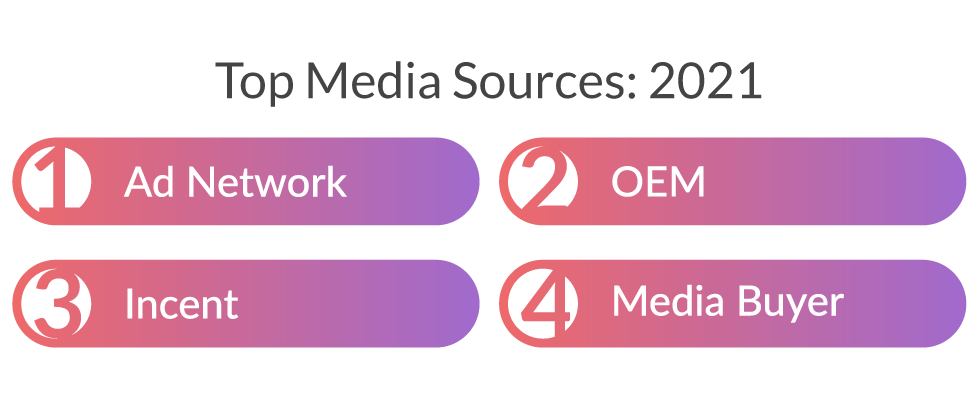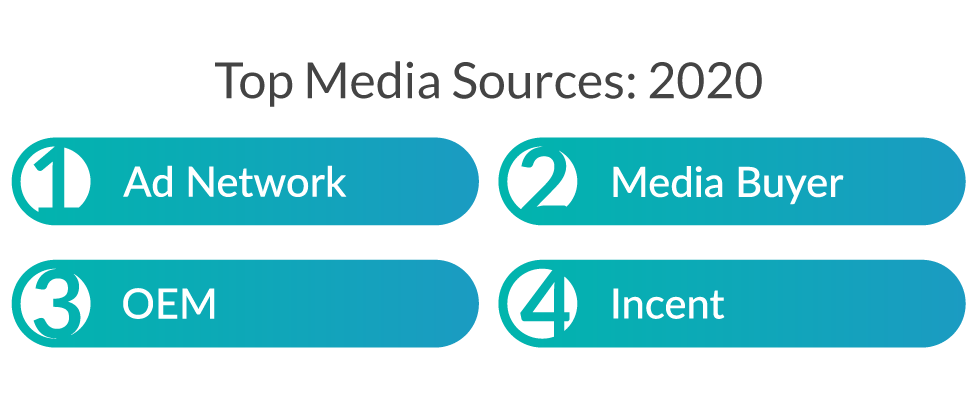Subscribe to our newsletter and get the latest resources sent to your inbox.

Looking Beyond Search and Social for App Growth
9 MIN READUser acquisition (UA) marketers are spending big to drive installs and there is no sign budgets will decrease anytime soon. According to AppsFlyer’s annual Global App Install Ad Spend projection, UA spending is going to continue to grow — increasing from $57.8 billion in 2019 to $118 billion in 2022. Much of this money will be spent on Google and Facebook ads, and on other social media networks. But, increasingly, app marketers are looking outside of these traditional search and social channels to find new audiences and the right users.
This trend has been accelerated by Apple’s decision to deprecate IDFA and implement App Tracking Transparency (ATT) and its own attribution tool, SKAdNetwork. “Apple’s advertising business has more than tripled its market share in the six months after it introduced privacy changes to iPhones that obstructed rivals, including Facebook and Google, from targeting ads at consumers,” according to Patrick McGee, a correspondent for the Financial Times. The impacts of these changes are being felt by advertisers. If you’ve maxed out your growth through search and social, or are finding that you are no longer able to target the right audiences in the wake of ATT, it may be time to expand your UA horizons to look at new growth channels.
Types of supply outside of search and social media
The supply landscape is often complex and overwhelming for small UA teams, but can be broken down into roughly ten categories:
- Ad Networks — Affiliate Networks aggregate all types of inventory across the ad ecosystem.
- DSPs — Programmatic Networks or DSPs automate the buying and selling of mobile ad inventory.
- Incent Networks — Incent Ad Networks are ad platforms that sell incentivized inventory.
- Media Buyers — Media Buyers purchase ad inventory directly from DSPs, exchanges, and individual websites.
- Mobile Web — Traffic is driven to an advertiser’s website through a mobile web browser that includes a landing page optimized for a conversion event.
- Native Platforms — A form of paid media where the ad experience mimics the natural form and function of the mobile web page or app.
- O+O — Direct app publishers that own and operate their properties/inventory.
- OEM/Preloads — Direct partnerships with cellular carriers and phone manufacturers that monetize their inventory via new device activations, push notifications, widgets, and pre-installed apps.
- POP Platforms — A platform serving ads that open over an active window for a mobile user.
- SDK Networks — Connect advertisers with in-app inventory.
It is often beneficial to find partners who understand how to navigate the different supply categories and apply rigorous testing to optimize your channels. For instance, we worked with a large FinTech client to identify direct media buyers with a proven track record of driving quality users. We turned to a small European-based partner that drove an 8.25% conversion rate from January through July and outperformed our initial goal as well as the app’s organic users. (Read the full case study here.)
To find new users, you must go where they are
Everyone is on social media — and we all use Google, right? Yes — and that’s why advertisers flock to these platforms, including your competition. If you want to find a competitive edge and access new audiences and markets, it’s time to get creative and diversify your UA channels.
Which channels you try will depend on your ideal user and the KPIs you want to measure, but there is an alternative growth channel for every goal! For instance, when one of our FinTech clients wanted to reach lower-income users with spotty credit histories, FeedMob integrated the client into new sources of inventory, focusing specifically on scaling carrier and original equipment manufacturer (OEM) partners. Not only did this approach drive higher conversions, we leveraged our tools to structure pricing based on performance — charging on a cost-per-install only if a user opens the app.
Growth channels that perform well without tracking data
If 2021 showed app marketers anything, it’s that diversifying your UA strategy is critical. Over reliance on identifying information is no longer an option, and finding channels that perform well without the use of tracking data is imperative to a balanced UA portfolio.
We have tested many channels since ATT went into effect and here are how the top trending sources of inventory changed in 2021 after ATT was introduced:


Posted: May 3, 2022
Category: Mobile Insights Blog, Mobile Performance Strategies
Tags: acquisition, channels, growth, search, social, strategy, supply

